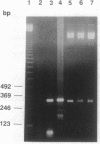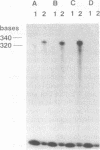Abstract
Degenerate oligonucleotide primers corresponding to conserved regions flanking the active-site domain of 1-aminocyclopropane-1-carboxylate (ACC) synthase (EC 4.4.1.14) were used for the polymerase chain reaction (PCR) to amplify DNA fragments from mRNA isolated from tomato fruit and tomato suspension cell culture. Antibodies raised against two conserved peptide sequences (TNPSNPLGTT and SLSKDLGLPGFRVG) were used to screen for positive colonies, after the PCR products were cloned into a Bluescript plasmid and expressed in Escherichia coli. Four distinct cDNA fragments encoding ACC synthase homologs were isolated. While pBTAS1 and pBTAS4 were obtained from fruit mRNA, cell culture mRNA yielded three sequences, pBTAS1, pBTAS2, and pBTAS3. Sequencing of these gene fragments revealed that pBTAS1 and pBTAS4 were identical to those full-length sequences previously reported by Van Der Straeten et al. [Van Der Straeten, D., Van Wiemeersch, L., Goodman, H. & Van Montague, M. (1990) Proc. Natl. Acad. Sci. USA 87, 4859-4863] and Olson et al. [Olson, D. C., White, J. A., Edelman, J., Harkin, R. N. & Kende, H. (1991) Proc. Natl. Acad. Sci. USA 88, 5340-5344] from tomato fruit, whereas pBTAS2 and pBTAS3 represent new sequences. Ribonuclease protection assays were used to examine the expression of these transcripts under three different conditions of enhanced ethylene production--namely, during fruit ripening, in response to mechanical wounding in fruit tissue, and auxin stimulation in vegetative tissue. Transcripts of pBTAS1 accumulated massively during ripening and wounding but only slightly in response to auxin treatment. Although pBTAS4 was associated with fruit ripening, it was unresponsive to auxin treatment in vegetative tissue. In contrast, the expression of pBTAS2 and pBTAS3 was greatly promoted in auxin-treated vegetative tissue but was absent from fruit tissue. While the expression of pBTAS2 was moderately dependent on wounding, pBTAS3 was unresponsive to wounding. These data support the view that ACC synthase is encoded by a multigene family and that the members are differentially expressed in response to developmental, environmental, and hormonal factors.
Full text
PDF




Images in this article
Selected References
These references are in PubMed. This may not be the complete list of references from this article.
- Bleecker A. B., Kenyon W. H., Somerville S. C., Kende H. Use of monoclonal antibodies in the purification and characterization of 1-aminocyclopropane-1-carboxylate synthase, an enzyme in ethylene biosynthesis. Proc Natl Acad Sci U S A. 1986 Oct;83(20):7755–7759. doi: 10.1073/pnas.83.20.7755. [DOI] [PMC free article] [PubMed] [Google Scholar]
- Gentry L. E., Rohrschneider L. R., Casnellie J. E., Krebs E. G. Antibodies to a defined region of pp60src neutralize the tyrosine-specific kinase activity. J Biol Chem. 1983 Sep 25;258(18):11219–11228. [PubMed] [Google Scholar]
- Green N., Alexander H., Olson A., Alexander S., Shinnick T. M., Sutcliffe J. G., Lerner R. A. Immunogenic structure of the influenza virus hemagglutinin. Cell. 1982 Mar;28(3):477–487. doi: 10.1016/0092-8674(82)90202-1. [DOI] [PubMed] [Google Scholar]
- Huang P. L., Parks J. E., Rottmann W. H., Theologis A. Two genes encoding 1-aminocyclopropane-1-carboxylate synthase in zucchini (Cucurbita pepo) are clustered and similar but differentially regulated. Proc Natl Acad Sci U S A. 1991 Aug 15;88(16):7021–7025. doi: 10.1073/pnas.88.16.7021. [DOI] [PMC free article] [PubMed] [Google Scholar]
- Lee J. J., Costlow N. A. A molecular titration assay to measure transcript prevalence levels. Methods Enzymol. 1987;152:633–648. doi: 10.1016/0076-6879(87)52070-5. [DOI] [PubMed] [Google Scholar]
- McMurchie E. J., McGlasson W. B., Eaks I. L. Treatment of fruit with propylene gives information about the biogenesis of ethylene. Nature. 1972 May 26;237(5352):235–236. doi: 10.1038/237235a0. [DOI] [PubMed] [Google Scholar]
- Mehta P. K., Hale T. I., Christen P. Evolutionary relationships among aminotransferases. Tyrosine aminotransferase, histidinol-phosphate aminotransferase, and aspartate aminotransferase are homologous proteins. Eur J Biochem. 1989 Dec 8;186(1-2):249–253. doi: 10.1111/j.1432-1033.1989.tb15202.x. [DOI] [PubMed] [Google Scholar]
- Olson D. C., White J. A., Edelman L., Harkins R. N., Kende H. Differential expression of two genes for 1-aminocyclopropane-1-carboxylate synthase in tomato fruits. Proc Natl Acad Sci U S A. 1991 Jun 15;88(12):5340–5344. doi: 10.1073/pnas.88.12.5340. [DOI] [PMC free article] [PubMed] [Google Scholar]
- Sato T., Oeller P. W., Theologis A. The 1-aminocyclopropane-1-carboxylate synthase of Cucurbita. Purification, properties, expression in Escherichia coli, and primary structure determination by DNA sequence analysis. J Biol Chem. 1991 Feb 25;266(6):3752–3759. [PubMed] [Google Scholar]
- Sato T., Theologis A. Cloning the mRNA encoding 1-aminocyclopropane-1-carboxylate synthase, the key enzyme for ethylene biosynthesis in plants. Proc Natl Acad Sci U S A. 1989 Sep;86(17):6621–6625. doi: 10.1073/pnas.86.17.6621. [DOI] [PMC free article] [PubMed] [Google Scholar]
- Satoh S., Yang S. F. S-adenosylmethionine-dependent inactivation and radiolabeling of 1-aminocyclopropane-1-carboxylate synthase isolated from tomato fruits. Plant Physiol. 1988 Sep;88(1):109–114. doi: 10.1104/pp.88.1.109. [DOI] [PMC free article] [PubMed] [Google Scholar]
- Van der Straeten D., Van Wiemeersch L., Goodman H. M., Van Montagu M. Cloning and sequence of two different cDNAs encoding 1-aminocyclopropane-1-carboxylate synthase in tomato. Proc Natl Acad Sci U S A. 1990 Jun;87(12):4859–4863. doi: 10.1073/pnas.87.12.4859. [DOI] [PMC free article] [PubMed] [Google Scholar]
- Wang A. M., Doyle M. V., Mark D. F. Quantitation of mRNA by the polymerase chain reaction. Proc Natl Acad Sci U S A. 1989 Dec;86(24):9717–9721. doi: 10.1073/pnas.86.24.9717. [DOI] [PMC free article] [PubMed] [Google Scholar]
- Yip W. K., Dong J. G., Kenny J. W., Thompson G. A., Yang S. F. Characterization and sequencing of the active site of 1-aminocyclopropane-1-carboxylate synthase. Proc Natl Acad Sci U S A. 1990 Oct;87(20):7930–7934. doi: 10.1073/pnas.87.20.7930. [DOI] [PMC free article] [PubMed] [Google Scholar]
- Yip W. K., Dong J. G., Yang S. F. Purification and characterization of 1-aminocyclopropane-1-carboxylate synthase from apple fruits. Plant Physiol. 1991 Jan;95(1):251–257. doi: 10.1104/pp.95.1.251. [DOI] [PMC free article] [PubMed] [Google Scholar]
- Yu Y. B., Adams D. O., Yang S. F. 1-Aminocyclopropanecarboxylate synthase, a key enzyme in ethylene biosynthesis. Arch Biochem Biophys. 1979 Nov;198(1):280–286. doi: 10.1016/0003-9861(79)90420-x. [DOI] [PubMed] [Google Scholar]





